Corporate Sponsorship's Contribution to CSR: A Dissertation Analysis
VerifiedAdded on 2022/08/18
|25
|8899
|11
Report
AI Summary
This report delves into the crucial role of corporate sponsorship in the realm of Corporate Social Responsibility (CSR). It explores the research question: How can corporate sponsorship of events contribute to a firm’s practice of CSR? The report begins by defining CSR, drawing upon various definitions from scholars and institutions like the European Union and the World Business Council for Sustainable Development, and discussing its evolution and importance. It then examines the stakeholder concept and its categories, emphasizing the significance of stakeholder engagement in successful CSR initiatives. The report analyzes how sponsorship events transform stakeholder attitudes, improve company productivity, and build stakeholder commitment. Furthermore, it outlines various approaches to CSR practices including philanthropic activities, corporate volunteerism, and cause-related marketing, and concludes by discussing the practices related to sponsoring of the events in CSR practices.
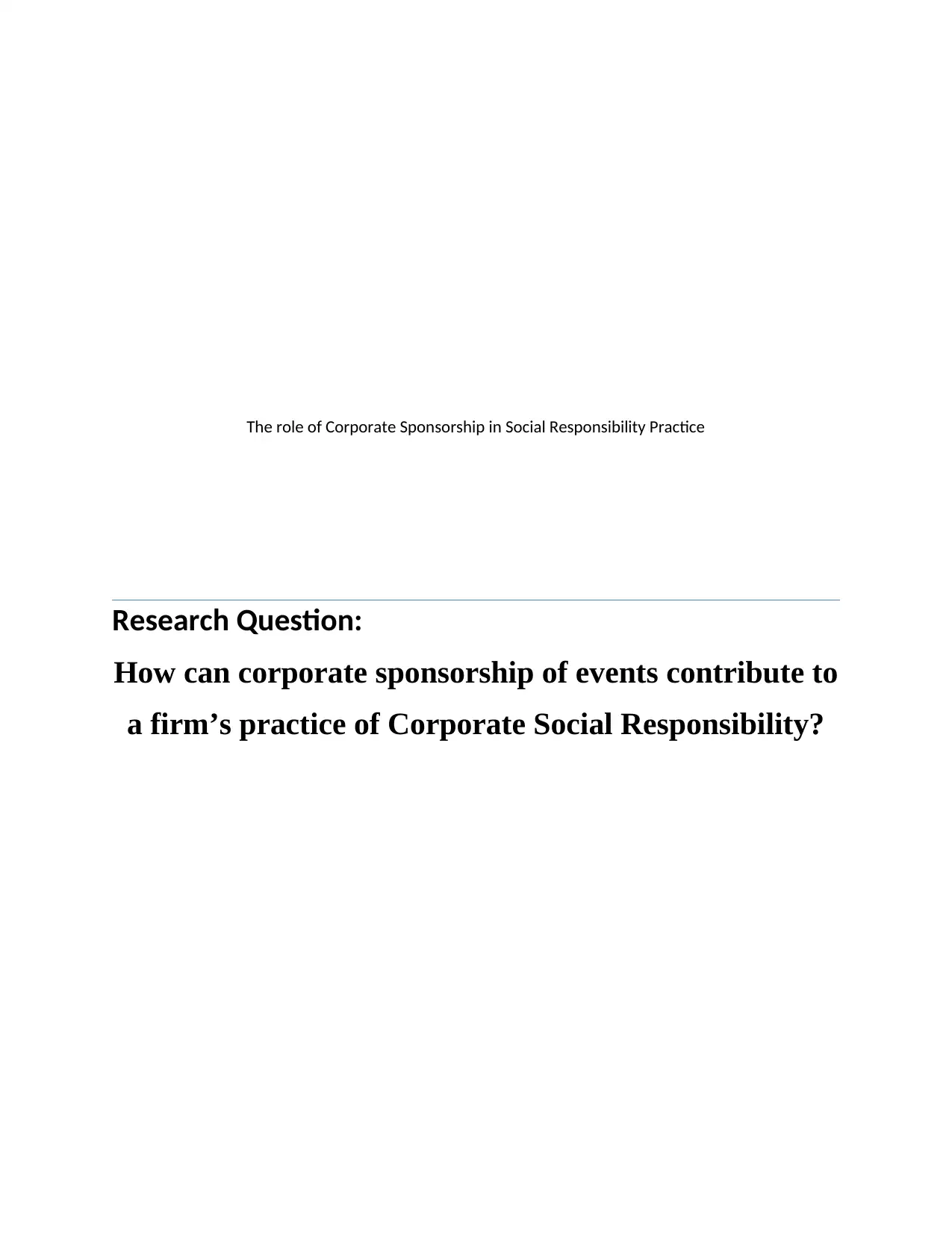
The role of Corporate Sponsorship in Social Responsibility Practice
Research Question:
How can corporate sponsorship of events contribute to
a firm’s practice of Corporate Social Responsibility?
Research Question:
How can corporate sponsorship of events contribute to
a firm’s practice of Corporate Social Responsibility?
Paraphrase This Document
Need a fresh take? Get an instant paraphrase of this document with our AI Paraphraser
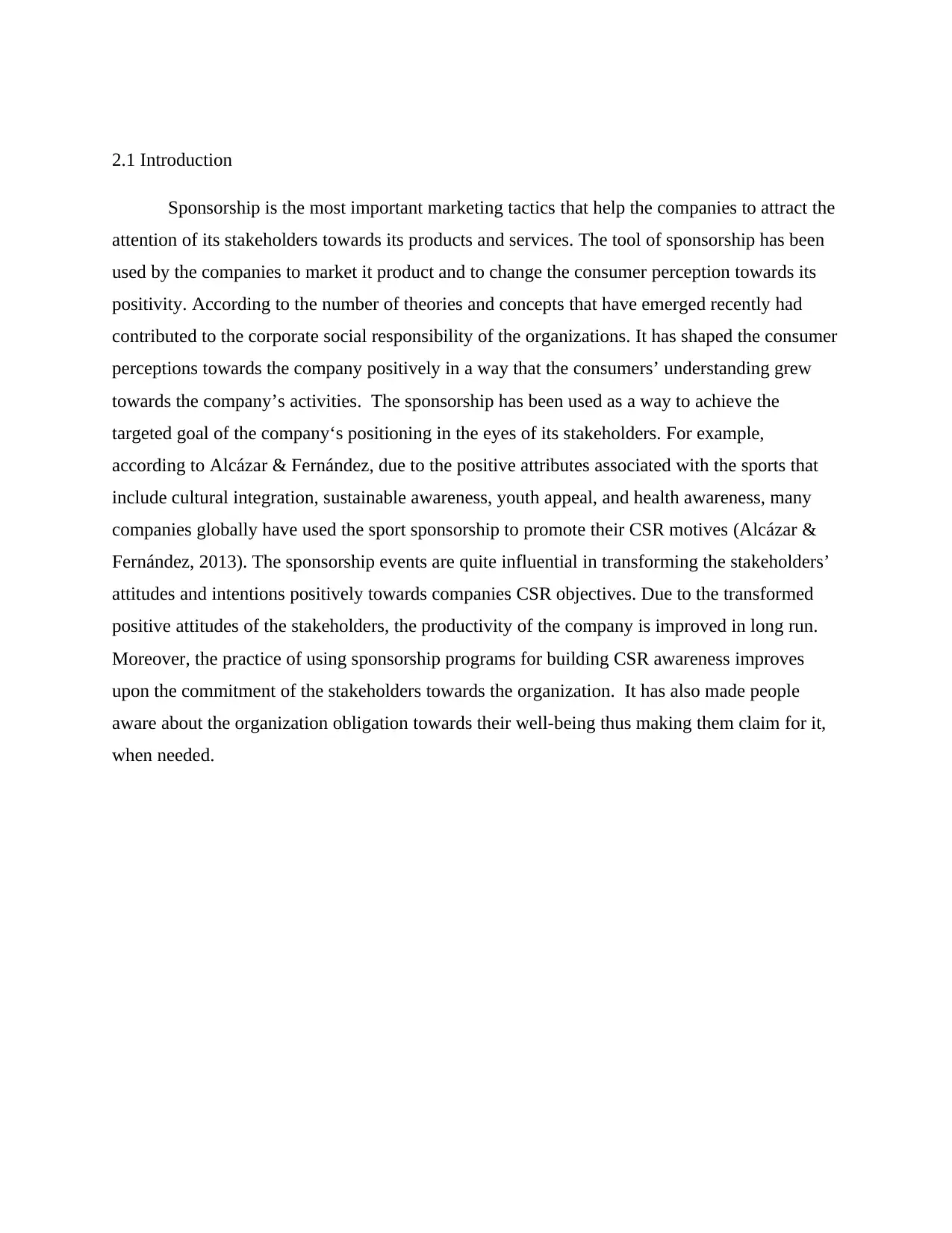
2.1 Introduction
Sponsorship is the most important marketing tactics that help the companies to attract the
attention of its stakeholders towards its products and services. The tool of sponsorship has been
used by the companies to market it product and to change the consumer perception towards its
positivity. According to the number of theories and concepts that have emerged recently had
contributed to the corporate social responsibility of the organizations. It has shaped the consumer
perceptions towards the company positively in a way that the consumers’ understanding grew
towards the company’s activities. The sponsorship has been used as a way to achieve the
targeted goal of the company‘s positioning in the eyes of its stakeholders. For example,
according to Alcázar & Fernández, due to the positive attributes associated with the sports that
include cultural integration, sustainable awareness, youth appeal, and health awareness, many
companies globally have used the sport sponsorship to promote their CSR motives (Alcázar &
Fernández, 2013). The sponsorship events are quite influential in transforming the stakeholders’
attitudes and intentions positively towards companies CSR objectives. Due to the transformed
positive attitudes of the stakeholders, the productivity of the company is improved in long run.
Moreover, the practice of using sponsorship programs for building CSR awareness improves
upon the commitment of the stakeholders towards the organization. It has also made people
aware about the organization obligation towards their well-being thus making them claim for it,
when needed.
Sponsorship is the most important marketing tactics that help the companies to attract the
attention of its stakeholders towards its products and services. The tool of sponsorship has been
used by the companies to market it product and to change the consumer perception towards its
positivity. According to the number of theories and concepts that have emerged recently had
contributed to the corporate social responsibility of the organizations. It has shaped the consumer
perceptions towards the company positively in a way that the consumers’ understanding grew
towards the company’s activities. The sponsorship has been used as a way to achieve the
targeted goal of the company‘s positioning in the eyes of its stakeholders. For example,
according to Alcázar & Fernández, due to the positive attributes associated with the sports that
include cultural integration, sustainable awareness, youth appeal, and health awareness, many
companies globally have used the sport sponsorship to promote their CSR motives (Alcázar &
Fernández, 2013). The sponsorship events are quite influential in transforming the stakeholders’
attitudes and intentions positively towards companies CSR objectives. Due to the transformed
positive attitudes of the stakeholders, the productivity of the company is improved in long run.
Moreover, the practice of using sponsorship programs for building CSR awareness improves
upon the commitment of the stakeholders towards the organization. It has also made people
aware about the organization obligation towards their well-being thus making them claim for it,
when needed.
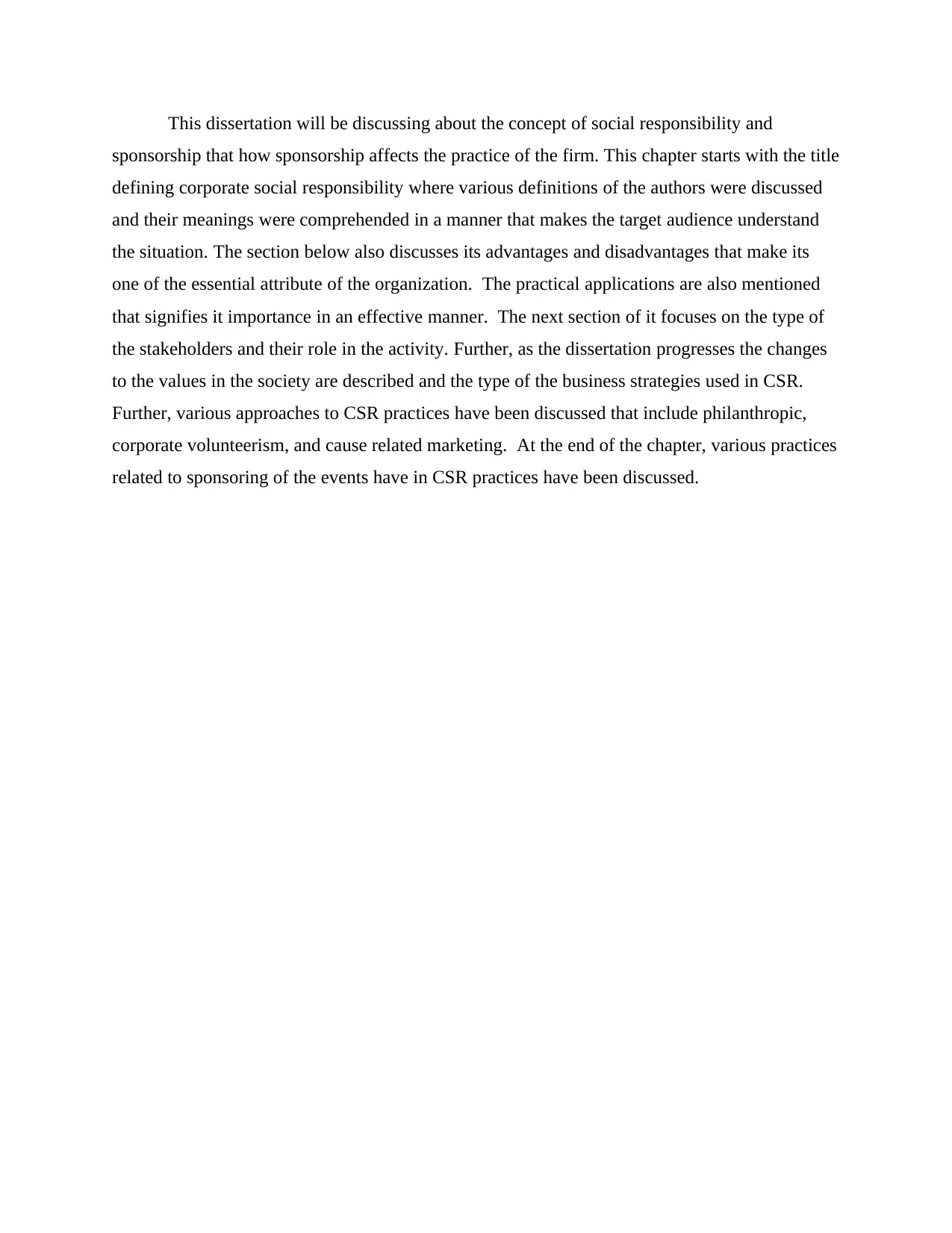
This dissertation will be discussing about the concept of social responsibility and
sponsorship that how sponsorship affects the practice of the firm. This chapter starts with the title
defining corporate social responsibility where various definitions of the authors were discussed
and their meanings were comprehended in a manner that makes the target audience understand
the situation. The section below also discusses its advantages and disadvantages that make its
one of the essential attribute of the organization. The practical applications are also mentioned
that signifies it importance in an effective manner. The next section of it focuses on the type of
the stakeholders and their role in the activity. Further, as the dissertation progresses the changes
to the values in the society are described and the type of the business strategies used in CSR.
Further, various approaches to CSR practices have been discussed that include philanthropic,
corporate volunteerism, and cause related marketing. At the end of the chapter, various practices
related to sponsoring of the events have in CSR practices have been discussed.
sponsorship that how sponsorship affects the practice of the firm. This chapter starts with the title
defining corporate social responsibility where various definitions of the authors were discussed
and their meanings were comprehended in a manner that makes the target audience understand
the situation. The section below also discusses its advantages and disadvantages that make its
one of the essential attribute of the organization. The practical applications are also mentioned
that signifies it importance in an effective manner. The next section of it focuses on the type of
the stakeholders and their role in the activity. Further, as the dissertation progresses the changes
to the values in the society are described and the type of the business strategies used in CSR.
Further, various approaches to CSR practices have been discussed that include philanthropic,
corporate volunteerism, and cause related marketing. At the end of the chapter, various practices
related to sponsoring of the events have in CSR practices have been discussed.
⊘ This is a preview!⊘
Do you want full access?
Subscribe today to unlock all pages.

Trusted by 1+ million students worldwide
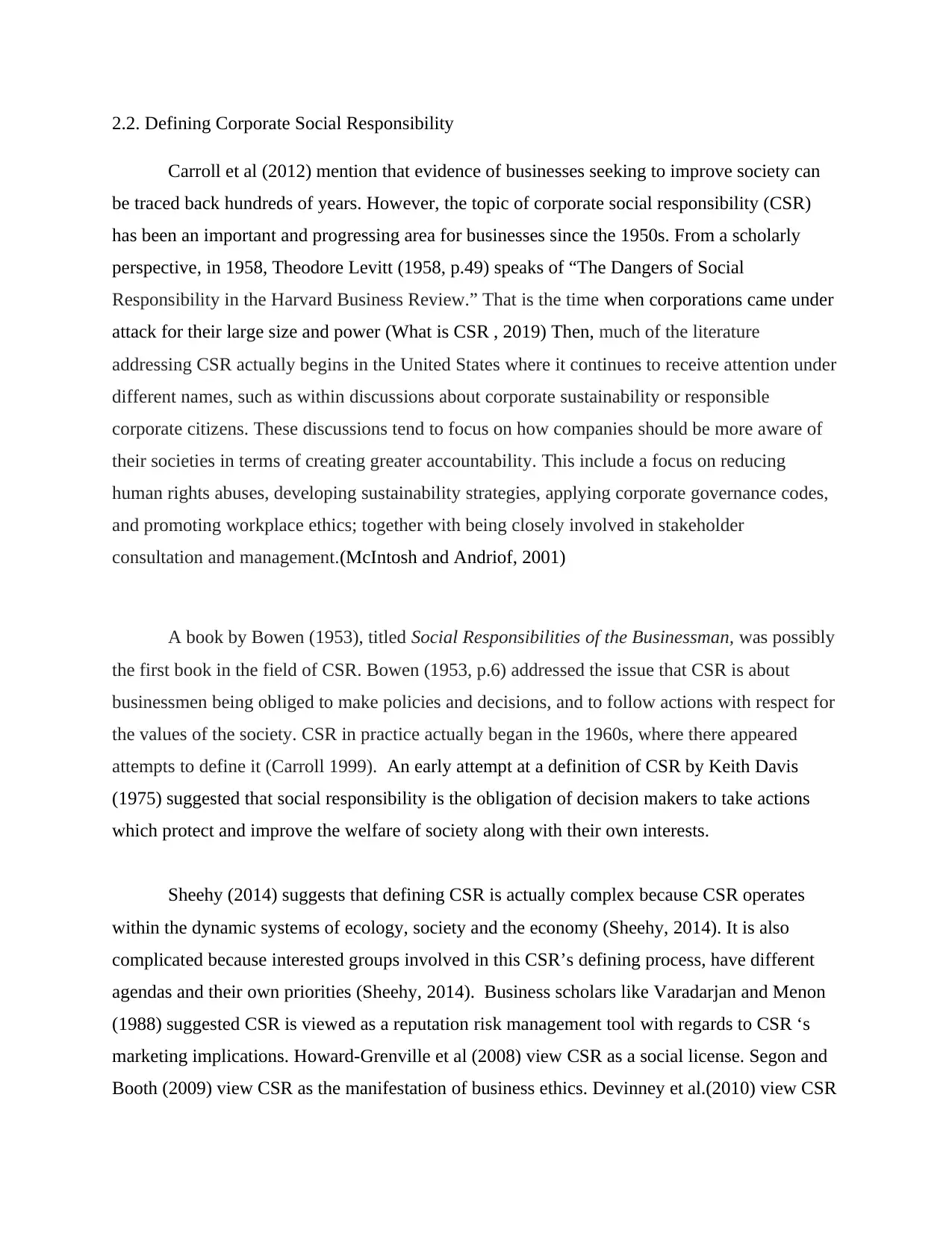
2.2. Defining Corporate Social Responsibility
Carroll et al (2012) mention that evidence of businesses seeking to improve society can
be traced back hundreds of years. However, the topic of corporate social responsibility (CSR)
has been an important and progressing area for businesses since the 1950s. From a scholarly
perspective, in 1958, Theodore Levitt (1958, p.49) speaks of “The Dangers of Social
Responsibility in the Harvard Business Review.” That is the time when corporations came under
attack for their large size and power (What is CSR , 2019) Then, much of the literature
addressing CSR actually begins in the United States where it continues to receive attention under
different names, such as within discussions about corporate sustainability or responsible
corporate citizens. These discussions tend to focus on how companies should be more aware of
their societies in terms of creating greater accountability. This include a focus on reducing
human rights abuses, developing sustainability strategies, applying corporate governance codes,
and promoting workplace ethics; together with being closely involved in stakeholder
consultation and management.(McIntosh and Andriof, 2001)
A book by Bowen (1953), titled Social Responsibilities of the Businessman, was possibly
the first book in the field of CSR. Bowen (1953, p.6) addressed the issue that CSR is about
businessmen being obliged to make policies and decisions, and to follow actions with respect for
the values of the society. CSR in practice actually began in the 1960s, where there appeared
attempts to define it (Carroll 1999). An early attempt at a definition of CSR by Keith Davis
(1975) suggested that social responsibility is the obligation of decision makers to take actions
which protect and improve the welfare of society along with their own interests.
Sheehy (2014) suggests that defining CSR is actually complex because CSR operates
within the dynamic systems of ecology, society and the economy (Sheehy, 2014). It is also
complicated because interested groups involved in this CSR’s defining process, have different
agendas and their own priorities (Sheehy, 2014). Business scholars like Varadarjan and Menon
(1988) suggested CSR is viewed as a reputation risk management tool with regards to CSR ‘s
marketing implications. Howard-Grenville et al (2008) view CSR as a social license. Segon and
Booth (2009) view CSR as the manifestation of business ethics. Devinney et al.(2010) view CSR
Carroll et al (2012) mention that evidence of businesses seeking to improve society can
be traced back hundreds of years. However, the topic of corporate social responsibility (CSR)
has been an important and progressing area for businesses since the 1950s. From a scholarly
perspective, in 1958, Theodore Levitt (1958, p.49) speaks of “The Dangers of Social
Responsibility in the Harvard Business Review.” That is the time when corporations came under
attack for their large size and power (What is CSR , 2019) Then, much of the literature
addressing CSR actually begins in the United States where it continues to receive attention under
different names, such as within discussions about corporate sustainability or responsible
corporate citizens. These discussions tend to focus on how companies should be more aware of
their societies in terms of creating greater accountability. This include a focus on reducing
human rights abuses, developing sustainability strategies, applying corporate governance codes,
and promoting workplace ethics; together with being closely involved in stakeholder
consultation and management.(McIntosh and Andriof, 2001)
A book by Bowen (1953), titled Social Responsibilities of the Businessman, was possibly
the first book in the field of CSR. Bowen (1953, p.6) addressed the issue that CSR is about
businessmen being obliged to make policies and decisions, and to follow actions with respect for
the values of the society. CSR in practice actually began in the 1960s, where there appeared
attempts to define it (Carroll 1999). An early attempt at a definition of CSR by Keith Davis
(1975) suggested that social responsibility is the obligation of decision makers to take actions
which protect and improve the welfare of society along with their own interests.
Sheehy (2014) suggests that defining CSR is actually complex because CSR operates
within the dynamic systems of ecology, society and the economy (Sheehy, 2014). It is also
complicated because interested groups involved in this CSR’s defining process, have different
agendas and their own priorities (Sheehy, 2014). Business scholars like Varadarjan and Menon
(1988) suggested CSR is viewed as a reputation risk management tool with regards to CSR ‘s
marketing implications. Howard-Grenville et al (2008) view CSR as a social license. Segon and
Booth (2009) view CSR as the manifestation of business ethics. Devinney et al.(2010) view CSR
Paraphrase This Document
Need a fresh take? Get an instant paraphrase of this document with our AI Paraphraser
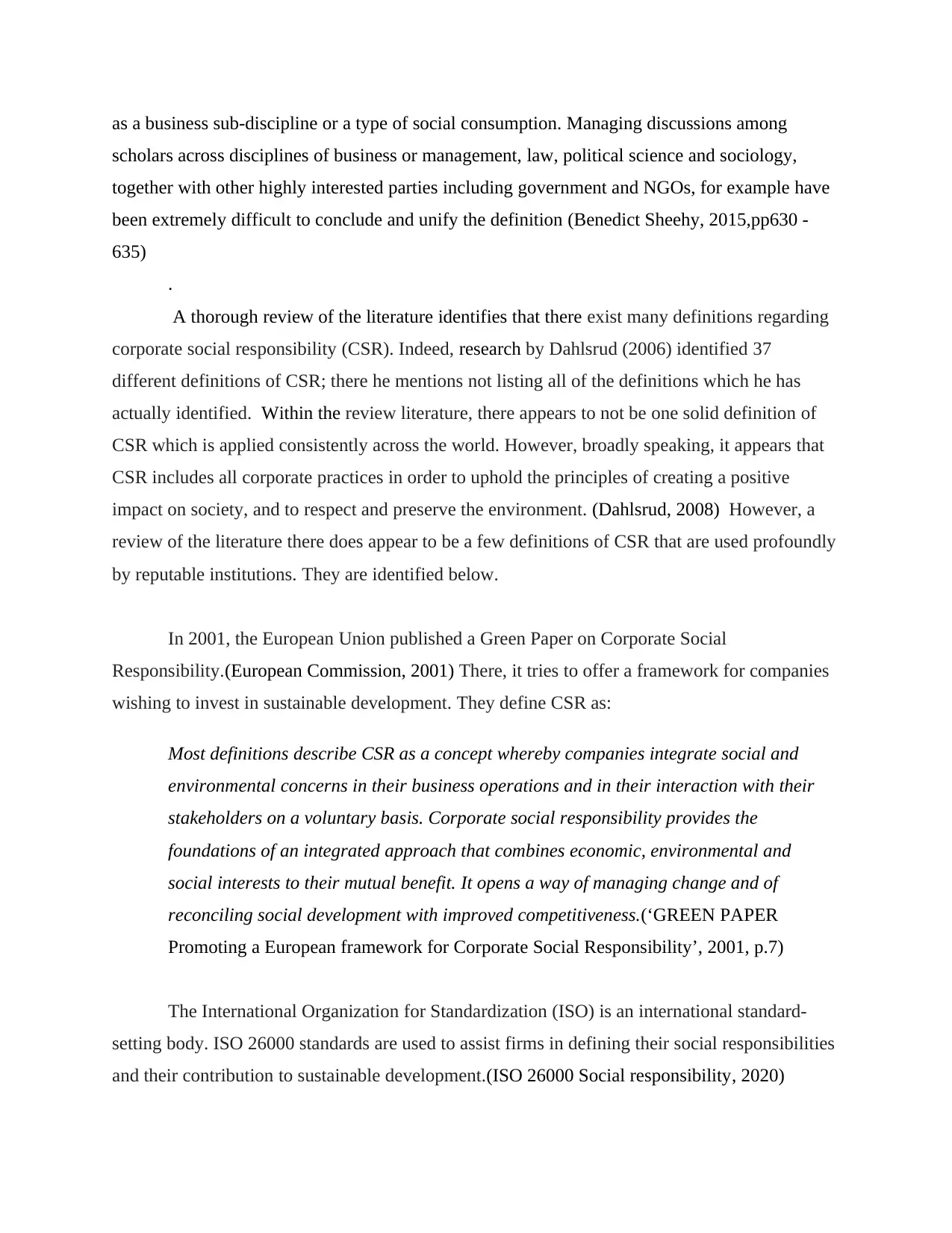
as a business sub-discipline or a type of social consumption. Managing discussions among
scholars across disciplines of business or management, law, political science and sociology,
together with other highly interested parties including government and NGOs, for example have
been extremely difficult to conclude and unify the definition (Benedict Sheehy, 2015,pp630 -
635)
.
A thorough review of the literature identifies that there exist many definitions regarding
corporate social responsibility (CSR). Indeed, research by Dahlsrud (2006) identified 37
different definitions of CSR; there he mentions not listing all of the definitions which he has
actually identified. Within the review literature, there appears to not be one solid definition of
CSR which is applied consistently across the world. However, broadly speaking, it appears that
CSR includes all corporate practices in order to uphold the principles of creating a positive
impact on society, and to respect and preserve the environment. (Dahlsrud, 2008) However, a
review of the literature there does appear to be a few definitions of CSR that are used profoundly
by reputable institutions. They are identified below.
In 2001, the European Union published a Green Paper on Corporate Social
Responsibility.(European Commission, 2001) There, it tries to offer a framework for companies
wishing to invest in sustainable development. They define CSR as:
Most definitions describe CSR as a concept whereby companies integrate social and
environmental concerns in their business operations and in their interaction with their
stakeholders on a voluntary basis. Corporate social responsibility provides the
foundations of an integrated approach that combines economic, environmental and
social interests to their mutual benefit. It opens a way of managing change and of
reconciling social development with improved competitiveness.(‘GREEN PAPER
Promoting a European framework for Corporate Social Responsibility’, 2001, p.7)
The International Organization for Standardization (ISO) is an international standard-
setting body. ISO 26000 standards are used to assist firms in defining their social responsibilities
and their contribution to sustainable development.(ISO 26000 Social responsibility, 2020)
scholars across disciplines of business or management, law, political science and sociology,
together with other highly interested parties including government and NGOs, for example have
been extremely difficult to conclude and unify the definition (Benedict Sheehy, 2015,pp630 -
635)
.
A thorough review of the literature identifies that there exist many definitions regarding
corporate social responsibility (CSR). Indeed, research by Dahlsrud (2006) identified 37
different definitions of CSR; there he mentions not listing all of the definitions which he has
actually identified. Within the review literature, there appears to not be one solid definition of
CSR which is applied consistently across the world. However, broadly speaking, it appears that
CSR includes all corporate practices in order to uphold the principles of creating a positive
impact on society, and to respect and preserve the environment. (Dahlsrud, 2008) However, a
review of the literature there does appear to be a few definitions of CSR that are used profoundly
by reputable institutions. They are identified below.
In 2001, the European Union published a Green Paper on Corporate Social
Responsibility.(European Commission, 2001) There, it tries to offer a framework for companies
wishing to invest in sustainable development. They define CSR as:
Most definitions describe CSR as a concept whereby companies integrate social and
environmental concerns in their business operations and in their interaction with their
stakeholders on a voluntary basis. Corporate social responsibility provides the
foundations of an integrated approach that combines economic, environmental and
social interests to their mutual benefit. It opens a way of managing change and of
reconciling social development with improved competitiveness.(‘GREEN PAPER
Promoting a European framework for Corporate Social Responsibility’, 2001, p.7)
The International Organization for Standardization (ISO) is an international standard-
setting body. ISO 26000 standards are used to assist firms in defining their social responsibilities
and their contribution to sustainable development.(ISO 26000 Social responsibility, 2020)
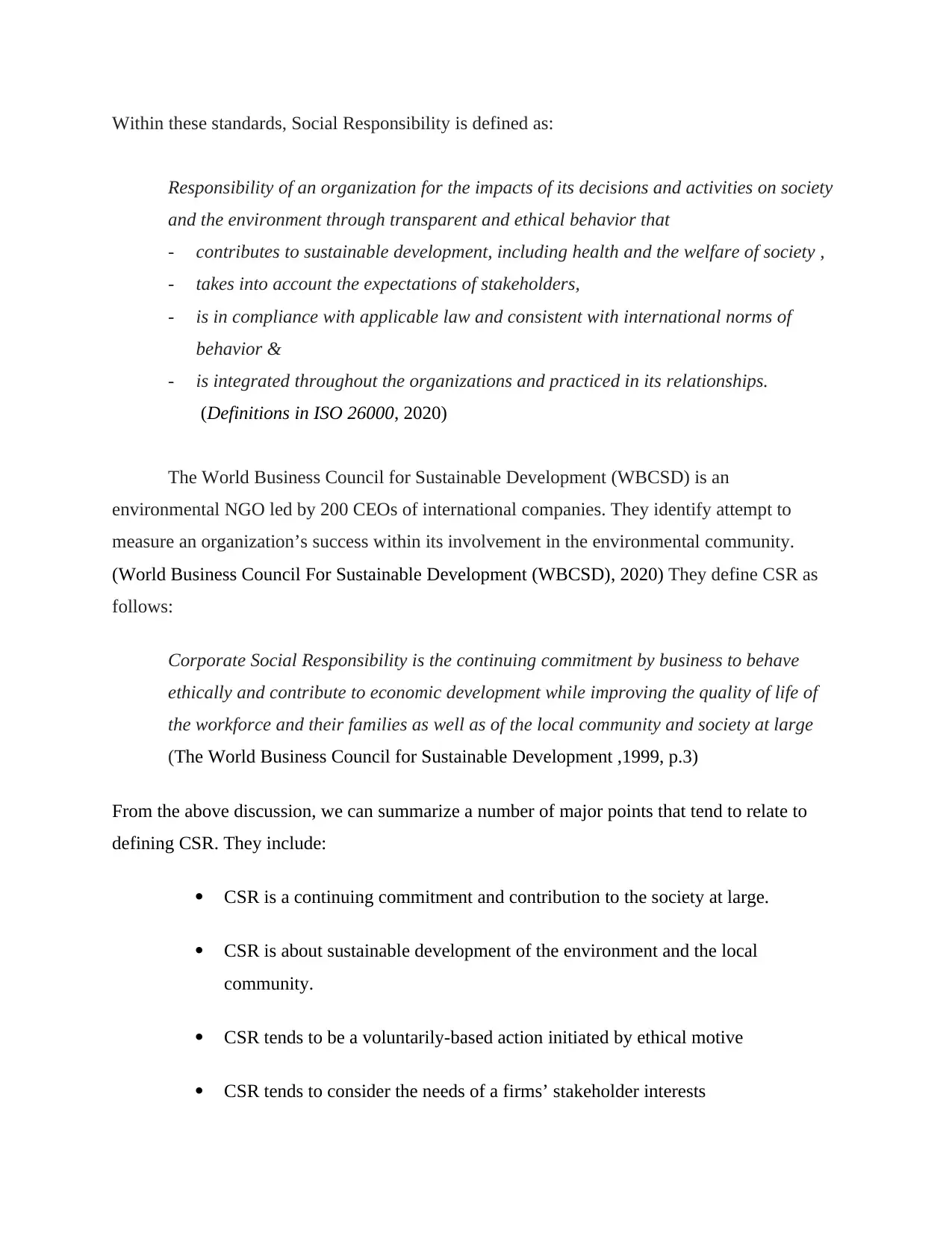
Within these standards, Social Responsibility is defined as:
Responsibility of an organization for the impacts of its decisions and activities on society
and the environment through transparent and ethical behavior that
- contributes to sustainable development, including health and the welfare of society ,
- takes into account the expectations of stakeholders,
- is in compliance with applicable law and consistent with international norms of
behavior &
- is integrated throughout the organizations and practiced in its relationships.
(Definitions in ISO 26000, 2020)
The World Business Council for Sustainable Development (WBCSD) is an
environmental NGO led by 200 CEOs of international companies. They identify attempt to
measure an organization’s success within its involvement in the environmental community.
(World Business Council For Sustainable Development (WBCSD), 2020) They define CSR as
follows:
Corporate Social Responsibility is the continuing commitment by business to behave
ethically and contribute to economic development while improving the quality of life of
the workforce and their families as well as of the local community and society at large
(The World Business Council for Sustainable Development ,1999, p.3)
From the above discussion, we can summarize a number of major points that tend to relate to
defining CSR. They include:
CSR is a continuing commitment and contribution to the society at large.
CSR is about sustainable development of the environment and the local
community.
CSR tends to be a voluntarily-based action initiated by ethical motive
CSR tends to consider the needs of a firms’ stakeholder interests
Responsibility of an organization for the impacts of its decisions and activities on society
and the environment through transparent and ethical behavior that
- contributes to sustainable development, including health and the welfare of society ,
- takes into account the expectations of stakeholders,
- is in compliance with applicable law and consistent with international norms of
behavior &
- is integrated throughout the organizations and practiced in its relationships.
(Definitions in ISO 26000, 2020)
The World Business Council for Sustainable Development (WBCSD) is an
environmental NGO led by 200 CEOs of international companies. They identify attempt to
measure an organization’s success within its involvement in the environmental community.
(World Business Council For Sustainable Development (WBCSD), 2020) They define CSR as
follows:
Corporate Social Responsibility is the continuing commitment by business to behave
ethically and contribute to economic development while improving the quality of life of
the workforce and their families as well as of the local community and society at large
(The World Business Council for Sustainable Development ,1999, p.3)
From the above discussion, we can summarize a number of major points that tend to relate to
defining CSR. They include:
CSR is a continuing commitment and contribution to the society at large.
CSR is about sustainable development of the environment and the local
community.
CSR tends to be a voluntarily-based action initiated by ethical motive
CSR tends to consider the needs of a firms’ stakeholder interests
⊘ This is a preview!⊘
Do you want full access?
Subscribe today to unlock all pages.

Trusted by 1+ million students worldwide
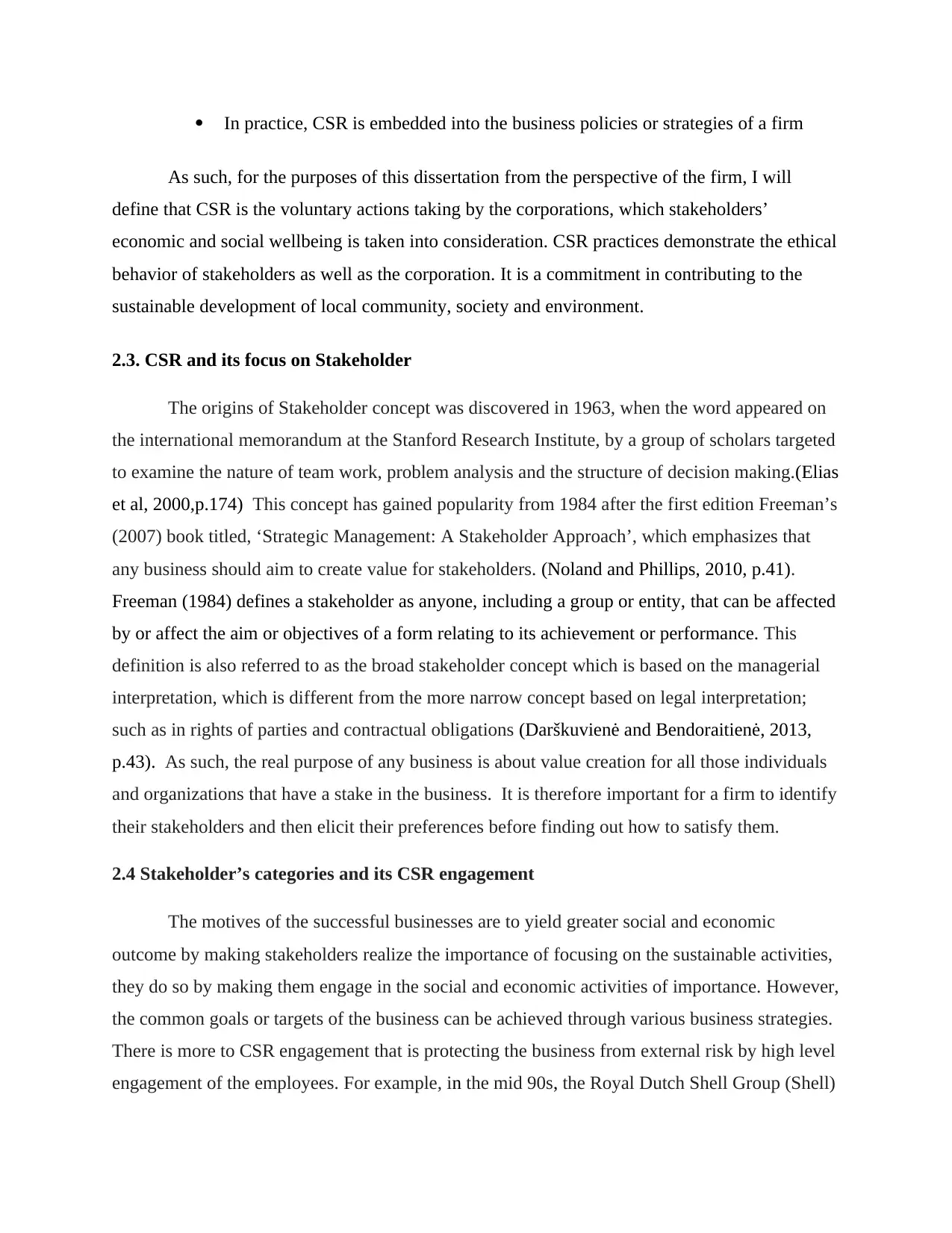
In practice, CSR is embedded into the business policies or strategies of a firm
As such, for the purposes of this dissertation from the perspective of the firm, I will
define that CSR is the voluntary actions taking by the corporations, which stakeholders’
economic and social wellbeing is taken into consideration. CSR practices demonstrate the ethical
behavior of stakeholders as well as the corporation. It is a commitment in contributing to the
sustainable development of local community, society and environment.
2.3. CSR and its focus on Stakeholder
The origins of Stakeholder concept was discovered in 1963, when the word appeared on
the international memorandum at the Stanford Research Institute, by a group of scholars targeted
to examine the nature of team work, problem analysis and the structure of decision making.(Elias
et al, 2000,p.174) This concept has gained popularity from 1984 after the first edition Freeman’s
(2007) book titled, ‘Strategic Management: A Stakeholder Approach’, which emphasizes that
any business should aim to create value for stakeholders. (Noland and Phillips, 2010, p.41).
Freeman (1984) defines a stakeholder as anyone, including a group or entity, that can be affected
by or affect the aim or objectives of a form relating to its achievement or performance. This
definition is also referred to as the broad stakeholder concept which is based on the managerial
interpretation, which is different from the more narrow concept based on legal interpretation;
such as in rights of parties and contractual obligations (Darškuvienė and Bendoraitienė, 2013,
p.43). As such, the real purpose of any business is about value creation for all those individuals
and organizations that have a stake in the business. It is therefore important for a firm to identify
their stakeholders and then elicit their preferences before finding out how to satisfy them.
2.4 Stakeholder’s categories and its CSR engagement
The motives of the successful businesses are to yield greater social and economic
outcome by making stakeholders realize the importance of focusing on the sustainable activities,
they do so by making them engage in the social and economic activities of importance. However,
the common goals or targets of the business can be achieved through various business strategies.
There is more to CSR engagement that is protecting the business from external risk by high level
engagement of the employees. For example, in the mid 90s, the Royal Dutch Shell Group (Shell)
As such, for the purposes of this dissertation from the perspective of the firm, I will
define that CSR is the voluntary actions taking by the corporations, which stakeholders’
economic and social wellbeing is taken into consideration. CSR practices demonstrate the ethical
behavior of stakeholders as well as the corporation. It is a commitment in contributing to the
sustainable development of local community, society and environment.
2.3. CSR and its focus on Stakeholder
The origins of Stakeholder concept was discovered in 1963, when the word appeared on
the international memorandum at the Stanford Research Institute, by a group of scholars targeted
to examine the nature of team work, problem analysis and the structure of decision making.(Elias
et al, 2000,p.174) This concept has gained popularity from 1984 after the first edition Freeman’s
(2007) book titled, ‘Strategic Management: A Stakeholder Approach’, which emphasizes that
any business should aim to create value for stakeholders. (Noland and Phillips, 2010, p.41).
Freeman (1984) defines a stakeholder as anyone, including a group or entity, that can be affected
by or affect the aim or objectives of a form relating to its achievement or performance. This
definition is also referred to as the broad stakeholder concept which is based on the managerial
interpretation, which is different from the more narrow concept based on legal interpretation;
such as in rights of parties and contractual obligations (Darškuvienė and Bendoraitienė, 2013,
p.43). As such, the real purpose of any business is about value creation for all those individuals
and organizations that have a stake in the business. It is therefore important for a firm to identify
their stakeholders and then elicit their preferences before finding out how to satisfy them.
2.4 Stakeholder’s categories and its CSR engagement
The motives of the successful businesses are to yield greater social and economic
outcome by making stakeholders realize the importance of focusing on the sustainable activities,
they do so by making them engage in the social and economic activities of importance. However,
the common goals or targets of the business can be achieved through various business strategies.
There is more to CSR engagement that is protecting the business from external risk by high level
engagement of the employees. For example, in the mid 90s, the Royal Dutch Shell Group (Shell)
Paraphrase This Document
Need a fresh take? Get an instant paraphrase of this document with our AI Paraphraser
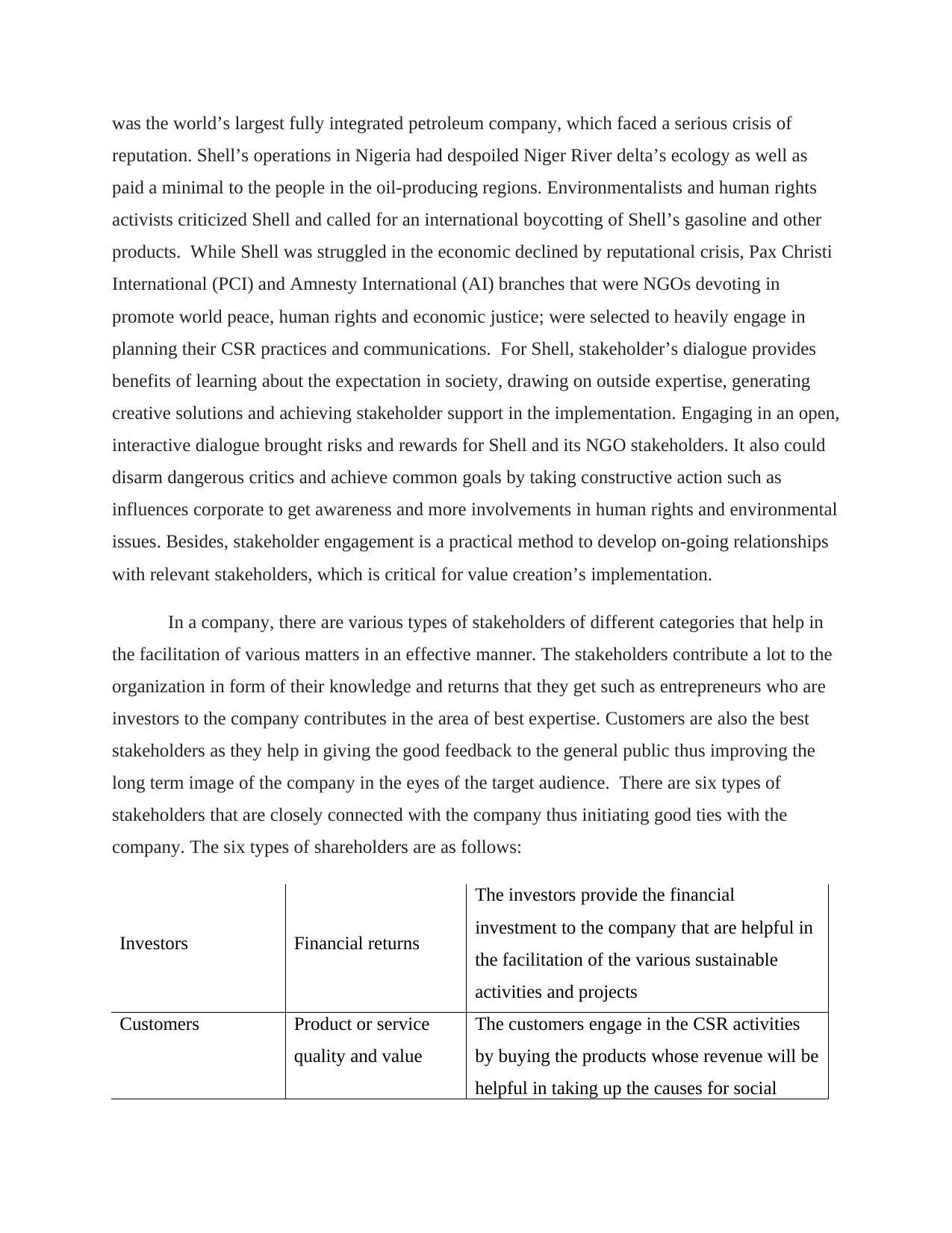
was the world’s largest fully integrated petroleum company, which faced a serious crisis of
reputation. Shell’s operations in Nigeria had despoiled Niger River delta’s ecology as well as
paid a minimal to the people in the oil-producing regions. Environmentalists and human rights
activists criticized Shell and called for an international boycotting of Shell’s gasoline and other
products. While Shell was struggled in the economic declined by reputational crisis, Pax Christi
International (PCI) and Amnesty International (AI) branches that were NGOs devoting in
promote world peace, human rights and economic justice; were selected to heavily engage in
planning their CSR practices and communications. For Shell, stakeholder’s dialogue provides
benefits of learning about the expectation in society, drawing on outside expertise, generating
creative solutions and achieving stakeholder support in the implementation. Engaging in an open,
interactive dialogue brought risks and rewards for Shell and its NGO stakeholders. It also could
disarm dangerous critics and achieve common goals by taking constructive action such as
influences corporate to get awareness and more involvements in human rights and environmental
issues. Besides, stakeholder engagement is a practical method to develop on-going relationships
with relevant stakeholders, which is critical for value creation’s implementation.
In a company, there are various types of stakeholders of different categories that help in
the facilitation of various matters in an effective manner. The stakeholders contribute a lot to the
organization in form of their knowledge and returns that they get such as entrepreneurs who are
investors to the company contributes in the area of best expertise. Customers are also the best
stakeholders as they help in giving the good feedback to the general public thus improving the
long term image of the company in the eyes of the target audience. There are six types of
stakeholders that are closely connected with the company thus initiating good ties with the
company. The six types of shareholders are as follows:
Investors Financial returns
The investors provide the financial
investment to the company that are helpful in
the facilitation of the various sustainable
activities and projects
Customers Product or service
quality and value
The customers engage in the CSR activities
by buying the products whose revenue will be
helpful in taking up the causes for social
reputation. Shell’s operations in Nigeria had despoiled Niger River delta’s ecology as well as
paid a minimal to the people in the oil-producing regions. Environmentalists and human rights
activists criticized Shell and called for an international boycotting of Shell’s gasoline and other
products. While Shell was struggled in the economic declined by reputational crisis, Pax Christi
International (PCI) and Amnesty International (AI) branches that were NGOs devoting in
promote world peace, human rights and economic justice; were selected to heavily engage in
planning their CSR practices and communications. For Shell, stakeholder’s dialogue provides
benefits of learning about the expectation in society, drawing on outside expertise, generating
creative solutions and achieving stakeholder support in the implementation. Engaging in an open,
interactive dialogue brought risks and rewards for Shell and its NGO stakeholders. It also could
disarm dangerous critics and achieve common goals by taking constructive action such as
influences corporate to get awareness and more involvements in human rights and environmental
issues. Besides, stakeholder engagement is a practical method to develop on-going relationships
with relevant stakeholders, which is critical for value creation’s implementation.
In a company, there are various types of stakeholders of different categories that help in
the facilitation of various matters in an effective manner. The stakeholders contribute a lot to the
organization in form of their knowledge and returns that they get such as entrepreneurs who are
investors to the company contributes in the area of best expertise. Customers are also the best
stakeholders as they help in giving the good feedback to the general public thus improving the
long term image of the company in the eyes of the target audience. There are six types of
stakeholders that are closely connected with the company thus initiating good ties with the
company. The six types of shareholders are as follows:
Investors Financial returns
The investors provide the financial
investment to the company that are helpful in
the facilitation of the various sustainable
activities and projects
Customers Product or service
quality and value
The customers engage in the CSR activities
by buying the products whose revenue will be
helpful in taking up the causes for social
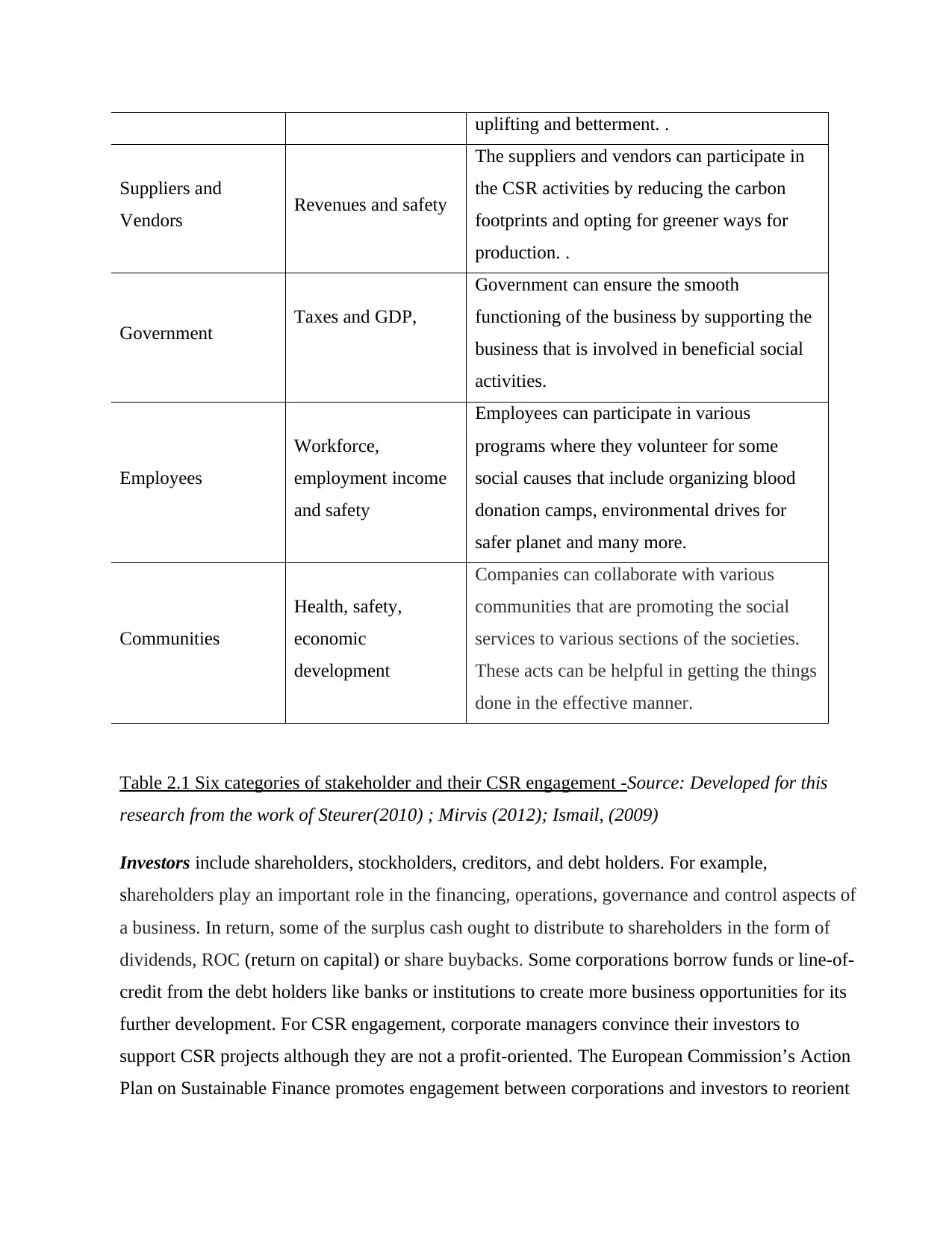
uplifting and betterment. .
Suppliers and
Vendors Revenues and safety
The suppliers and vendors can participate in
the CSR activities by reducing the carbon
footprints and opting for greener ways for
production. .
Government Taxes and GDP,
Government can ensure the smooth
functioning of the business by supporting the
business that is involved in beneficial social
activities.
Employees
Workforce,
employment income
and safety
Employees can participate in various
programs where they volunteer for some
social causes that include organizing blood
donation camps, environmental drives for
safer planet and many more.
Communities
Health, safety,
economic
development
Companies can collaborate with various
communities that are promoting the social
services to various sections of the societies.
These acts can be helpful in getting the things
done in the effective manner.
Table 2.1 Six categories of stakeholder and their CSR engagement -Source: Developed for this
research from the work of Steurer(2010) ; Mirvis (2012); Ismail, (2009)
Investors include shareholders, stockholders, creditors, and debt holders. For example,
shareholders play an important role in the financing, operations, governance and control aspects of
a business. In return, some of the surplus cash ought to distribute to shareholders in the form of
dividends, ROC (return on capital) or share buybacks. Some corporations borrow funds or line-of-
credit from the debt holders like banks or institutions to create more business opportunities for its
further development. For CSR engagement, corporate managers convince their investors to
support CSR projects although they are not a profit-oriented. The European Commission’s Action
Plan on Sustainable Finance promotes engagement between corporations and investors to reorient
Suppliers and
Vendors Revenues and safety
The suppliers and vendors can participate in
the CSR activities by reducing the carbon
footprints and opting for greener ways for
production. .
Government Taxes and GDP,
Government can ensure the smooth
functioning of the business by supporting the
business that is involved in beneficial social
activities.
Employees
Workforce,
employment income
and safety
Employees can participate in various
programs where they volunteer for some
social causes that include organizing blood
donation camps, environmental drives for
safer planet and many more.
Communities
Health, safety,
economic
development
Companies can collaborate with various
communities that are promoting the social
services to various sections of the societies.
These acts can be helpful in getting the things
done in the effective manner.
Table 2.1 Six categories of stakeholder and their CSR engagement -Source: Developed for this
research from the work of Steurer(2010) ; Mirvis (2012); Ismail, (2009)
Investors include shareholders, stockholders, creditors, and debt holders. For example,
shareholders play an important role in the financing, operations, governance and control aspects of
a business. In return, some of the surplus cash ought to distribute to shareholders in the form of
dividends, ROC (return on capital) or share buybacks. Some corporations borrow funds or line-of-
credit from the debt holders like banks or institutions to create more business opportunities for its
further development. For CSR engagement, corporate managers convince their investors to
support CSR projects although they are not a profit-oriented. The European Commission’s Action
Plan on Sustainable Finance promotes engagement between corporations and investors to reorient
⊘ This is a preview!⊘
Do you want full access?
Subscribe today to unlock all pages.

Trusted by 1+ million students worldwide
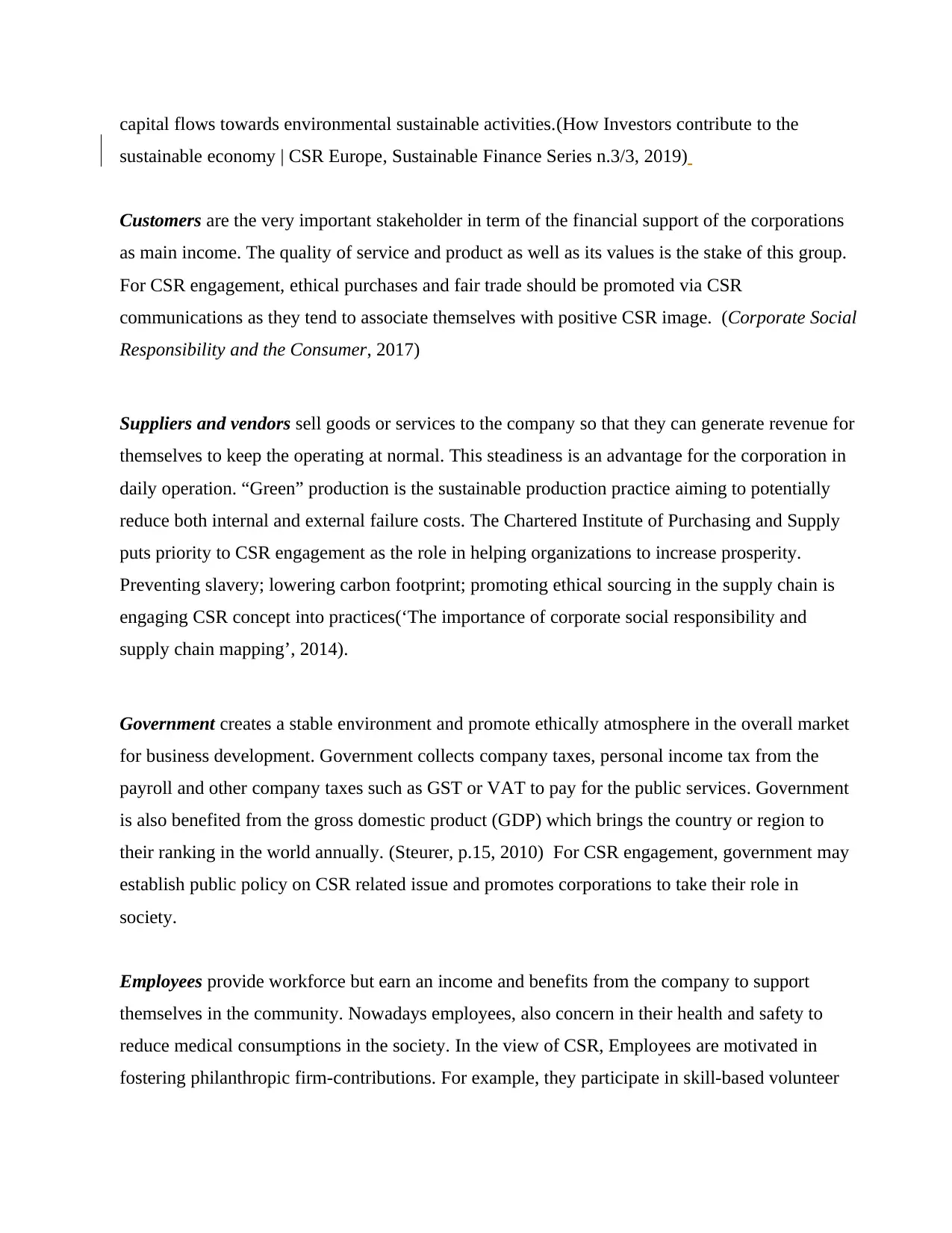
capital flows towards environmental sustainable activities.(How Investors contribute to the
sustainable economy | CSR Europe, Sustainable Finance Series n.3/3, 2019)
Customers are the very important stakeholder in term of the financial support of the corporations
as main income. The quality of service and product as well as its values is the stake of this group.
For CSR engagement, ethical purchases and fair trade should be promoted via CSR
communications as they tend to associate themselves with positive CSR image. (Corporate Social
Responsibility and the Consumer, 2017)
Suppliers and vendors sell goods or services to the company so that they can generate revenue for
themselves to keep the operating at normal. This steadiness is an advantage for the corporation in
daily operation. “Green” production is the sustainable production practice aiming to potentially
reduce both internal and external failure costs. The Chartered Institute of Purchasing and Supply
puts priority to CSR engagement as the role in helping organizations to increase prosperity.
Preventing slavery; lowering carbon footprint; promoting ethical sourcing in the supply chain is
engaging CSR concept into practices(‘The importance of corporate social responsibility and
supply chain mapping’, 2014).
Government creates a stable environment and promote ethically atmosphere in the overall market
for business development. Government collects company taxes, personal income tax from the
payroll and other company taxes such as GST or VAT to pay for the public services. Government
is also benefited from the gross domestic product (GDP) which brings the country or region to
their ranking in the world annually. (Steurer, p.15, 2010) For CSR engagement, government may
establish public policy on CSR related issue and promotes corporations to take their role in
society.
Employees provide workforce but earn an income and benefits from the company to support
themselves in the community. Nowadays employees, also concern in their health and safety to
reduce medical consumptions in the society. In the view of CSR, Employees are motivated in
fostering philanthropic firm-contributions. For example, they participate in skill-based volunteer
sustainable economy | CSR Europe, Sustainable Finance Series n.3/3, 2019)
Customers are the very important stakeholder in term of the financial support of the corporations
as main income. The quality of service and product as well as its values is the stake of this group.
For CSR engagement, ethical purchases and fair trade should be promoted via CSR
communications as they tend to associate themselves with positive CSR image. (Corporate Social
Responsibility and the Consumer, 2017)
Suppliers and vendors sell goods or services to the company so that they can generate revenue for
themselves to keep the operating at normal. This steadiness is an advantage for the corporation in
daily operation. “Green” production is the sustainable production practice aiming to potentially
reduce both internal and external failure costs. The Chartered Institute of Purchasing and Supply
puts priority to CSR engagement as the role in helping organizations to increase prosperity.
Preventing slavery; lowering carbon footprint; promoting ethical sourcing in the supply chain is
engaging CSR concept into practices(‘The importance of corporate social responsibility and
supply chain mapping’, 2014).
Government creates a stable environment and promote ethically atmosphere in the overall market
for business development. Government collects company taxes, personal income tax from the
payroll and other company taxes such as GST or VAT to pay for the public services. Government
is also benefited from the gross domestic product (GDP) which brings the country or region to
their ranking in the world annually. (Steurer, p.15, 2010) For CSR engagement, government may
establish public policy on CSR related issue and promotes corporations to take their role in
society.
Employees provide workforce but earn an income and benefits from the company to support
themselves in the community. Nowadays employees, also concern in their health and safety to
reduce medical consumptions in the society. In the view of CSR, Employees are motivated in
fostering philanthropic firm-contributions. For example, they participate in skill-based volunteer
Paraphrase This Document
Need a fresh take? Get an instant paraphrase of this document with our AI Paraphraser
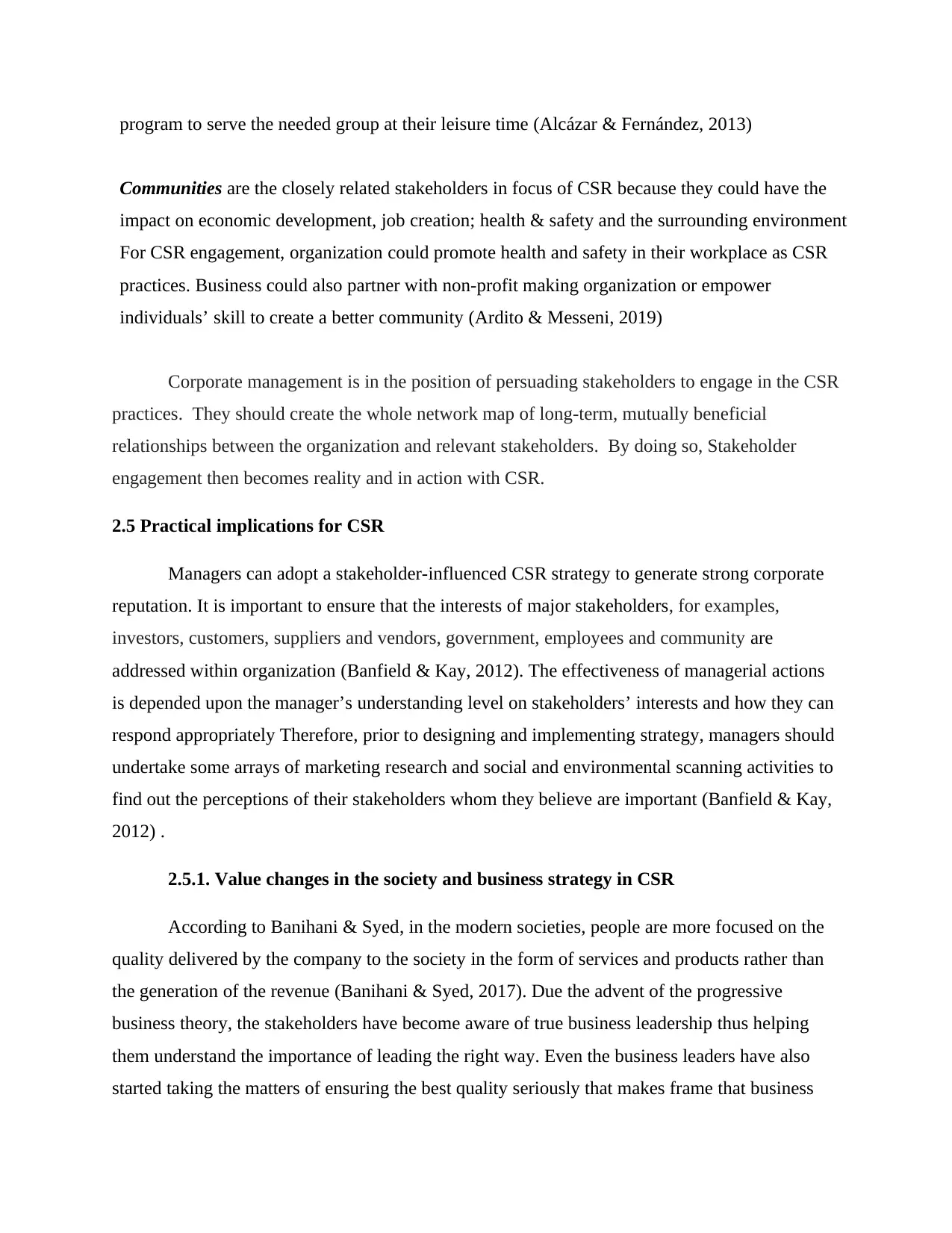
program to serve the needed group at their leisure time (Alcázar & Fernández, 2013)
Communities are the closely related stakeholders in focus of CSR because they could have the
impact on economic development, job creation; health & safety and the surrounding environment
For CSR engagement, organization could promote health and safety in their workplace as CSR
practices. Business could also partner with non-profit making organization or empower
individuals’ skill to create a better community (Ardito & Messeni, 2019)
Corporate management is in the position of persuading stakeholders to engage in the CSR
practices. They should create the whole network map of long-term, mutually beneficial
relationships between the organization and relevant stakeholders. By doing so, Stakeholder
engagement then becomes reality and in action with CSR.
2.5 Practical implications for CSR
Managers can adopt a stakeholder-influenced CSR strategy to generate strong corporate
reputation. It is important to ensure that the interests of major stakeholders, for examples,
investors, customers, suppliers and vendors, government, employees and community are
addressed within organization (Banfield & Kay, 2012). The effectiveness of managerial actions
is depended upon the manager’s understanding level on stakeholders’ interests and how they can
respond appropriately Therefore, prior to designing and implementing strategy, managers should
undertake some arrays of marketing research and social and environmental scanning activities to
find out the perceptions of their stakeholders whom they believe are important (Banfield & Kay,
2012) .
2.5.1. Value changes in the society and business strategy in CSR
According to Banihani & Syed, in the modern societies, people are more focused on the
quality delivered by the company to the society in the form of services and products rather than
the generation of the revenue (Banihani & Syed, 2017). Due the advent of the progressive
business theory, the stakeholders have become aware of true business leadership thus helping
them understand the importance of leading the right way. Even the business leaders have also
started taking the matters of ensuring the best quality seriously that makes frame that business
Communities are the closely related stakeholders in focus of CSR because they could have the
impact on economic development, job creation; health & safety and the surrounding environment
For CSR engagement, organization could promote health and safety in their workplace as CSR
practices. Business could also partner with non-profit making organization or empower
individuals’ skill to create a better community (Ardito & Messeni, 2019)
Corporate management is in the position of persuading stakeholders to engage in the CSR
practices. They should create the whole network map of long-term, mutually beneficial
relationships between the organization and relevant stakeholders. By doing so, Stakeholder
engagement then becomes reality and in action with CSR.
2.5 Practical implications for CSR
Managers can adopt a stakeholder-influenced CSR strategy to generate strong corporate
reputation. It is important to ensure that the interests of major stakeholders, for examples,
investors, customers, suppliers and vendors, government, employees and community are
addressed within organization (Banfield & Kay, 2012). The effectiveness of managerial actions
is depended upon the manager’s understanding level on stakeholders’ interests and how they can
respond appropriately Therefore, prior to designing and implementing strategy, managers should
undertake some arrays of marketing research and social and environmental scanning activities to
find out the perceptions of their stakeholders whom they believe are important (Banfield & Kay,
2012) .
2.5.1. Value changes in the society and business strategy in CSR
According to Banihani & Syed, in the modern societies, people are more focused on the
quality delivered by the company to the society in the form of services and products rather than
the generation of the revenue (Banihani & Syed, 2017). Due the advent of the progressive
business theory, the stakeholders have become aware of true business leadership thus helping
them understand the importance of leading the right way. Even the business leaders have also
started taking the matters of ensuring the best quality seriously that makes frame that business
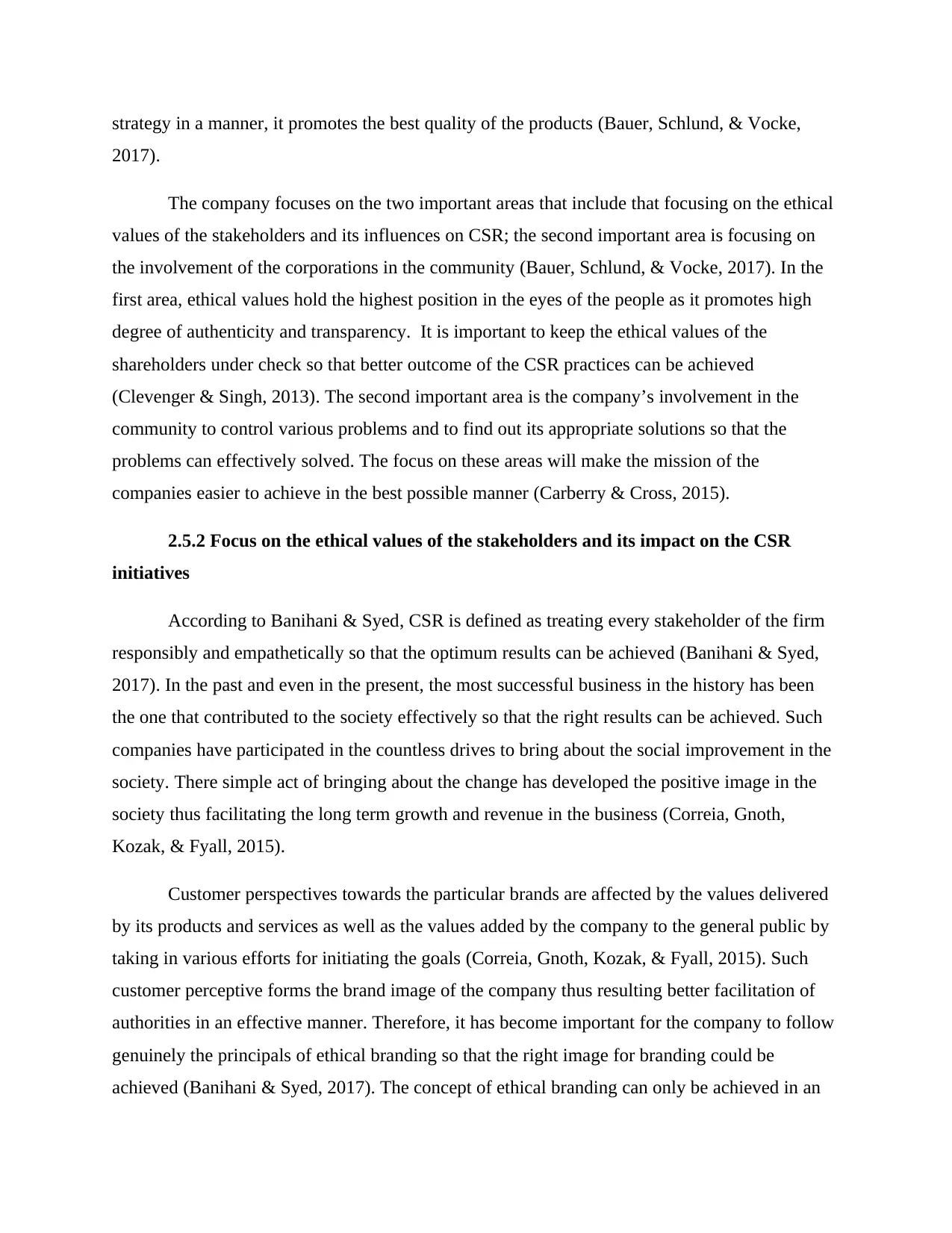
strategy in a manner, it promotes the best quality of the products (Bauer, Schlund, & Vocke,
2017).
The company focuses on the two important areas that include that focusing on the ethical
values of the stakeholders and its influences on CSR; the second important area is focusing on
the involvement of the corporations in the community (Bauer, Schlund, & Vocke, 2017). In the
first area, ethical values hold the highest position in the eyes of the people as it promotes high
degree of authenticity and transparency. It is important to keep the ethical values of the
shareholders under check so that better outcome of the CSR practices can be achieved
(Clevenger & Singh, 2013). The second important area is the company’s involvement in the
community to control various problems and to find out its appropriate solutions so that the
problems can effectively solved. The focus on these areas will make the mission of the
companies easier to achieve in the best possible manner (Carberry & Cross, 2015).
2.5.2 Focus on the ethical values of the stakeholders and its impact on the CSR
initiatives
According to Banihani & Syed, CSR is defined as treating every stakeholder of the firm
responsibly and empathetically so that the optimum results can be achieved (Banihani & Syed,
2017). In the past and even in the present, the most successful business in the history has been
the one that contributed to the society effectively so that the right results can be achieved. Such
companies have participated in the countless drives to bring about the social improvement in the
society. There simple act of bringing about the change has developed the positive image in the
society thus facilitating the long term growth and revenue in the business (Correia, Gnoth,
Kozak, & Fyall, 2015).
Customer perspectives towards the particular brands are affected by the values delivered
by its products and services as well as the values added by the company to the general public by
taking in various efforts for initiating the goals (Correia, Gnoth, Kozak, & Fyall, 2015). Such
customer perceptive forms the brand image of the company thus resulting better facilitation of
authorities in an effective manner. Therefore, it has become important for the company to follow
genuinely the principals of ethical branding so that the right image for branding could be
achieved (Banihani & Syed, 2017). The concept of ethical branding can only be achieved in an
2017).
The company focuses on the two important areas that include that focusing on the ethical
values of the stakeholders and its influences on CSR; the second important area is focusing on
the involvement of the corporations in the community (Bauer, Schlund, & Vocke, 2017). In the
first area, ethical values hold the highest position in the eyes of the people as it promotes high
degree of authenticity and transparency. It is important to keep the ethical values of the
shareholders under check so that better outcome of the CSR practices can be achieved
(Clevenger & Singh, 2013). The second important area is the company’s involvement in the
community to control various problems and to find out its appropriate solutions so that the
problems can effectively solved. The focus on these areas will make the mission of the
companies easier to achieve in the best possible manner (Carberry & Cross, 2015).
2.5.2 Focus on the ethical values of the stakeholders and its impact on the CSR
initiatives
According to Banihani & Syed, CSR is defined as treating every stakeholder of the firm
responsibly and empathetically so that the optimum results can be achieved (Banihani & Syed,
2017). In the past and even in the present, the most successful business in the history has been
the one that contributed to the society effectively so that the right results can be achieved. Such
companies have participated in the countless drives to bring about the social improvement in the
society. There simple act of bringing about the change has developed the positive image in the
society thus facilitating the long term growth and revenue in the business (Correia, Gnoth,
Kozak, & Fyall, 2015).
Customer perspectives towards the particular brands are affected by the values delivered
by its products and services as well as the values added by the company to the general public by
taking in various efforts for initiating the goals (Correia, Gnoth, Kozak, & Fyall, 2015). Such
customer perceptive forms the brand image of the company thus resulting better facilitation of
authorities in an effective manner. Therefore, it has become important for the company to follow
genuinely the principals of ethical branding so that the right image for branding could be
achieved (Banihani & Syed, 2017). The concept of ethical branding can only be achieved in an
⊘ This is a preview!⊘
Do you want full access?
Subscribe today to unlock all pages.

Trusted by 1+ million students worldwide
1 out of 25
Related Documents
Your All-in-One AI-Powered Toolkit for Academic Success.
+13062052269
info@desklib.com
Available 24*7 on WhatsApp / Email
![[object Object]](/_next/static/media/star-bottom.7253800d.svg)
Unlock your academic potential
Copyright © 2020–2025 A2Z Services. All Rights Reserved. Developed and managed by ZUCOL.




